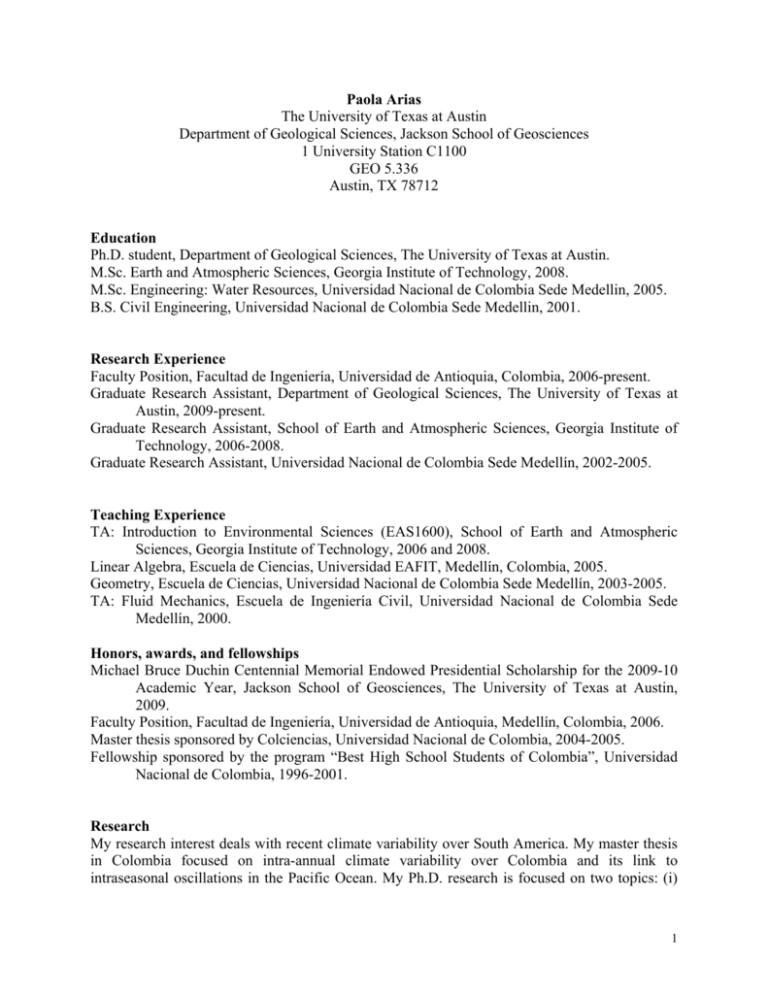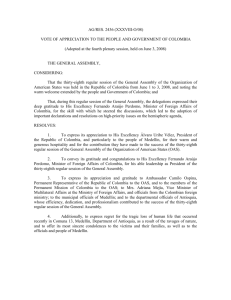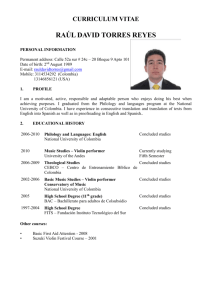CV - The Department of Geological Sciences
advertisement

Paola Arias The University of Texas at Austin Department of Geological Sciences, Jackson School of Geosciences 1 University Station C1100 GEO 5.336 Austin, TX 78712 Education Ph.D. student, Department of Geological Sciences, The University of Texas at Austin. M.Sc. Earth and Atmospheric Sciences, Georgia Institute of Technology, 2008. M.Sc. Engineering: Water Resources, Universidad Nacional de Colombia Sede Medellin, 2005. B.S. Civil Engineering, Universidad Nacional de Colombia Sede Medellin, 2001. Research Experience Faculty Position, Facultad de Ingeniería, Universidad de Antioquia, Colombia, 2006-present. Graduate Research Assistant, Department of Geological Sciences, The University of Texas at Austin, 2009-present. Graduate Research Assistant, School of Earth and Atmospheric Sciences, Georgia Institute of Technology, 2006-2008. Graduate Research Assistant, Universidad Nacional de Colombia Sede Medellín, 2002-2005. Teaching Experience TA: Introduction to Environmental Sciences (EAS1600), School of Earth and Atmospheric Sciences, Georgia Institute of Technology, 2006 and 2008. Linear Algebra, Escuela de Ciencias, Universidad EAFIT, Medellín, Colombia, 2005. Geometry, Escuela de Ciencias, Universidad Nacional de Colombia Sede Medellín, 2003-2005. TA: Fluid Mechanics, Escuela de Ingeniería Civil, Universidad Nacional de Colombia Sede Medellín, 2000. Honors, awards, and fellowships Michael Bruce Duchin Centennial Memorial Endowed Presidential Scholarship for the 2009-10 Academic Year, Jackson School of Geosciences, The University of Texas at Austin, 2009. Faculty Position, Facultad de Ingeniería, Universidad de Antioquia, Medellín, Colombia, 2006. Master thesis sponsored by Colciencias, Universidad Nacional de Colombia, 2004-2005. Fellowship sponsored by the program “Best High School Students of Colombia”, Universidad Nacional de Colombia, 1996-2001. Research My research interest deals with recent climate variability over South America. My master thesis in Colombia focused on intra-annual climate variability over Colombia and its link to intraseasonal oscillations in the Pacific Ocean. My Ph.D. research is focused on two topics: (i) 1 how convective cloudiness has changed over the Amazon forests during the recent decades and which are the possible causes for these changes and (ii) how North America and South America Monsoon Systems interact between them. I am currently looking for the possible causes for a delayed onset of the North American Monsoon with the aim of understanding which mechanisms play a more important role and linking them to the also observed delayed onset of the wet season over the Amazon forests. Decadal changes in cloudiness over the Amazon forests Tropical forests contain as much as 40% of the carbon stored as terrestrial biomass and account for 30 to 50% of terrestrial productivity. 54% of the contingent rainforest is located in the Amazon basin. This river basin also provides 18% of global fresh water discharge. Through its control on evapotranspiration and runoff, rainforest plays an important role in regulating the water cycle in this basin. Thus, the fate of Amazon rainforest has important consequence to the global carbon and water cycle. The fate of the rainforests are primarily influenced by land use and climate change. The former, especially the conversion of forest to pasture, has been documented by many previous studies, whereas latter is more subtle and largely unclearly. Changes in rainforest growth and mortality rates, especially in the deep and least perturbed forest areas, have been consistently observed across global tropics in recent decades. Previous studies have suggested that such a change may be caused by an elevated atmospheric CO2 and increasing surface temperature. However, the rainforests in wet tropical regions are mostly light limited and changes in atmospheric circulation and radiation balance over tropical oceans have been reported, although it is not clear how cloudiness has changed over tropical land. My research has shown a decadal-scale decrease of seasonal mean convection, cloudiness and shortwave (SW) downwelling radiation during 1984 to 2007 over the Amazon basin. These changes are consistent with observed increase in surface temperature and reduction of moisture transport to the Amazon basin. Our analysis suggests that this observed change in cloudiness is linked to of the Pacific Decadal Oscillation (PDO) and the expansion of the western Pacific warm pool during December-February season, to the Atlantic Multidecadal Oscillation during March-May season, and to the tropical Atlantic SST gradient during September-November season [Arias et al., 2009, in preparation]. Possible causes for a delayed onset of the North American Monsoon Monsoon precipitation over North America and northwest Mexico has important implications in both society and economy. Reliable and accurate forecasting is necessary, especially now that society awareness of global climate change increases. Our preliminary analyses have evidenced a delay in the onset of the North American Monsoon. Warming in troposphere requires higher surface air buoyancy to convect and high loss of soil moisture would reduce rainfall during the dry to wet transition over the monsoon region. On the other hand, higher surface temperature and precipitable water enhance rainfall intensity during wet season and high loss of soil moisture increase dryness in the dry season. However, earlier warming of land surface temperature could lead to earlier monsoon onset in North America. Which mechanism will be stronger is unclear. 2 This part of my research aims to identify which possible causes could produce the observed delay of the North American Monsoon onset. We consider three possible causes: (i) stronger land-ocean surface temperature contrast, (ii) stronger eastern Pacific ITZC, and (iii) relaxation of the lapse rate over the monsoon region due to tropospheric warming. Publications Arias, P., R. Fu, C. Hoyos, and W. Li, 2009: Decadal changes in cloudiness over the Amazon forests: Observations and potential causes. In preparation to Climate Dynamics. Arias, P. A. and G. Poveda, 2007: Estimación de la relación adimensional de Budyko en Colombia. Revista de la Academia Colombiana de Ciencias Exactas, Físicas y Naturales, 31 (118), 69-78 (in spanish). Poveda, G., O. J. Mesa, L. F. Salazar, P. A. Arias, H. Moreno, S. C. Vieira, P.A. Agudelo, V.G. Toro, and J. F. Álvarez, 2005: Diurnal cycle of precipitation in the tropical Andes of Colombia. Monthly Weather Review, 133(1), 228-240. Arias, P. A. and G. Poveda, 2005: Efecto de la desagregacion temporal sobre la coherencia espacial de la precipitación en Colombia. Avances en Recursos Hidráulicos, No. 12, 135-147 (in spanish). Poveda, G., O. J. Mesa, P. A. Agudelo, J. F. Álvarez, P. A. Arias, H. A. Moreno, L. F. Salazar, V. G. Toro, and S. C. Vieira, 2002: Influencia del ENSO, Oscilación Madden-Julian, Ondas del Este, Huracanes y Fases de la Luna en el Ciclo Diurno de la Precipitación en los Andes Tropicales de Colombia. Meteorología Colombiana, No. 5, 3-12 (in spanish). Poveda, G., O. J. Mesa, P. A. Agudelo, J. F. Álvarez, P. A. Arias, H. A. Moreno, L. F. Salazar, V. G. Toro, S. C. Vieira, A. Jaramillo, and O. Guzman, 2002: Diagnóstico del Ciclo Diurno de la Precipitación en los Andes Tropicales de Colombia. Meteorología Colombiana, No. 5, 23-30 (in spanish). Poveda, G. O. J. Mesa, P. A. Agudelo, J. F. Álvarez, P. A. Arias, H. A. Moreno, L. F. Salazar, V. G. Toro y S. C. Vieira, 2002: Diagnóstico del Ciclo Anual y Efectos del ENSO sobre la intensidad máxima de lluvias de duración entre 1 y 24 horas en los Andes de Colombia. Meteorología Colombiana, No. 5, 67-74 (in spanish). Talks and presentations Arias, P., R. Fu, C. Hoyos, and W. Li. Decadal changes in cloudiness over the Amazon forests: Observations and potential causes. Accepted for presentation in the 90th AMS Annual Meeting, Atlanta, GA, January 2010. 3 Arias, P., R. Fu, and W. Li. Changes in cloudiness over tropical land during the last decades and its link to global climate change. AGU Fall Meeting, San Francisco, CA, December 2007. 4




